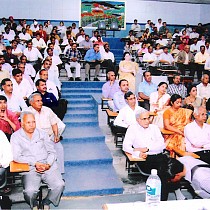PATTERN OF RESISTANCE AND TOXICITY OF SOME INSECTICIDES TO TWO POPULATIONS OF HELICOVERPA ARMIGERA (HUB.) FROM HARYANA
Department of Entomology, CCS Haryana Agricultural University, Hisar – 125 004 (India)
H.R. ROHILLA, RAVIDRANATH, S. HEGDE AND R.K. SAINI
Two meta- populations of Helicoverpa armigera (Hub.) collected from Sirsa (more pesticide use) and Bhiwani (less pesticide use) areas of Haryana were evaluated for their susceptibility to four commercial formulations of insecticides i.e., profenofos (Carina) 50 EC, fenvalerate (Fennock) 20 EC, endosulfan (Thiodan) 35 EC and monocrotophos (Kadett) 36 SL in the laboratory at 27±2oC. The insecticide dissolved in acetone were applied to the larvae weighing 30-50 mg @ 1 ìl/larva by topical application method. Observations on toxicity were recorded at 24, 48 and 72h of application. The Sirsa population showed resistance to all the four insecticides when compared with Bhiwani population at all the three observation intervals. The resistance ratios in Sirsa population over Bhiwani population to profenofos, fenvalerate, endosulfan and monocrotophos were 3.88, 1.44, 4.70 and 2.60 at 24h exposure; 3.46, 2.35, 4.65 and 1.13 at 48h exposure and 2.50, 2.89, 3.65 and 1.13 at 72h exposure, respectively. This indicated that the insecticides were more toxic to Bhiwani populations as compared to Sirsa population and the differences in relative toxicity were more pronounced at 72h after application. Monocrotophos was found to be the least toxic and profenofos the most toxic to both the populations. As compared to the Bhiwani population, the Sirsa population of H. armigera was 2.5, 2.89, 3.66, and 1.13 times more tolerant to profenofos, fenvalerate, endosulfan and monocrotophos, respectively when observed after 72h of exposure.


